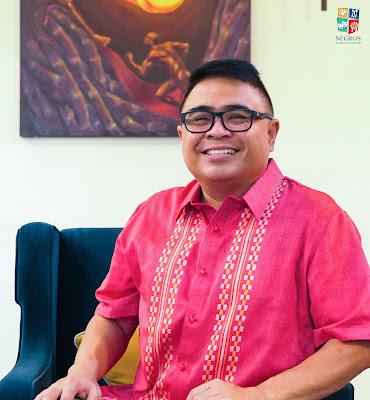 |
| Resource speakers at the UNESCO bid presentation, August 2024 – Gov. Bong Lacson, Dr. Ivan Henares, Neil Solo Locsin, Gabriel Caballero. |
The Philippine islands of Negros and Panay in Western Visayas are now tentatively nominated by the United Nations Educational, Scientific and Cultural Organization (UNESCO) Philippines in a bid to be included as a world heritage site.
The bid, entitled “The Sugar Cultural Landscape of Negros and Panay Islands” was submitted under UNESCO’s cultural category. It showcases the legacy of the sugar industry through the industrialization of sugar production in the late 18th century. This includes the structures, systems, properties, and communities reflecting the social and economic aspects of the late Spanish and American colonial eras.
 |
| Attendees at the UNESCO bid presentation, August 2024 – Issa Urra, Mayee Fabregas, Reena Gamboa.
|
In collaboration with the Negros Occidental Historical Council, the Negros Museum, Department of Tourism, and the Office of the Governor they hope to actively engage local communities in this bid.
The event that was organized and spearheaded by the Negros Occidental provincial government, led by Governor Eugenio ‘Bong’ Lacson, together with the local Department of Tourism. The key drivers of the project and main resource speakers at the event are Ivan Henares, Gabriel Caballero and Solo Locsin.
How do we define and concretize the culture of sugar in our local landscape? How do we capture its past heritage and evolving present – elements and influences that led to the formation and foundation of the Negrense native soul? What do we include in celebration of the vibrancy it birthed and encompassed? In our way of life, politics, priorities, arts and culture? In its diversity, duality and polarization? What did the introduction and industry of sugar do for local communities and the world stage?
 |
| World Heritage Bid presenters at the UNESCO Sugar Cultural Landscape Event - Bacolod City, August 2024. |
The study seeks to stimulate the trail’s conservation and preservation by outlining its significant value to the community, analyzing points of concern, and presenting what it can contribute to Western Visayas and to the Philippines.
The Philippines lags behind other Asian countries in conservation efforts of its important natural and cultural heritage sites. Fewer World Heritage Site requests are ascribed to little awareness among locals, deficiency of competent people involved, and the lack of government funding for conservation and monitoring efforts.
Advocacies are overlooked or drowned out by mega developments and urban expansion. Sugar plantations, facilities and haciendas are steadily being replaced by subdivisions, freeways and high rises.
 |
| World Heritage Bid resource speaker, Ivan Henares – Secretary General, UNESCO Philippines. |
A cultural landscape is a place with many layers of history that evolve through design and use over time. A cultural landscape embodies the associations and uses that evoke a sense of history for a specific place.
Physical features of cultural landscapes can include trees, buildings, pathways, site furnishings, water bodies – basically any element that expresses cultural values and the history of a site.
Cultural landscapes also include intangible elements such as land use and association of people that influenced the development of a landscape. The sugar landscape of our local islands includes city historic centers, mills, haciendas, ancestral homes, transport and trading sites.
 |
| World Heritage Bid resource speaker, Gabriel Caballero - Consultant, UNESCO Philippines. |
What reflects a significant picture of native history and the journey of sugar production on the island - a main economic driver of Negros for over a century until the present. The seven initial UNESCO sites targeted are by no means final - more places are already being considered for inclusion.
Our sugar stories and heritage are not confined nor centralized to a single perspective or location. More often a series of interrelated sites across a wide landscape will indicate how production was organized, transported to a place of manufacture, transformed into goods and services, and distributed to markets across the world.
Cultural landscapes are significant for their association with historical events, activities, and people. The sugar cultural landscape stories are meant to focus on how the importance of place in our heritage requires recognition beyond the structures built that shaped the environment.
 |
| World Heritage Bid resource speaker, Neil Solomon Locsin – Chairman, Negros Historical Council. |
By including as many varied sectors of the community we can grow engagement and vested interests that build the elements of the sugar landscape more significantly. Universities, LGUs and the private sector can contribute manpower, archives and studies for research and development. In turn students, residents and advocates gain the value and importance of our sugar history and heritage.
Cultural landscape preservation seeks to recognize significant landscape features and place making to better understand evolving community and cultural values. Everywhere people live and move about they interact with their environment - creating cultural ideals through the use and transformation of their surroundings.
It is our hope that the local community can relate this story of a rich sugar cultural landscape that has and continues to shape a vista that encourages its residents and visitors to keep these treasures alive and thriving in our daily lives. To better preserve and protect what will be a future world heritage site for us all.
Article by: Issa Urra (bhaktiCD.org)
Video script by: Mayee Fabregas
Photos and video by: Unit A Creatives








